
NOSRETI transports anything that is longer, wider, higher or heavier than normal
Economics & Logistics
NOSRETI Specialtransport has transported just about everything that is longer, wider, higher or heavier than road regulations normally permit. The company’s latest highlight: a power station component for Slovakia.
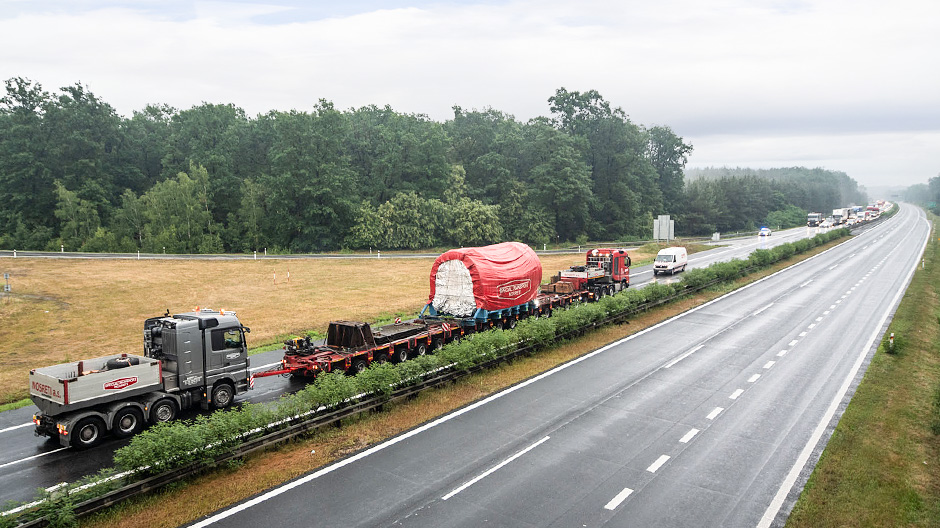
The stator which NOSRETI transported for the Mochovce power station in the west of Slovakia weighs 184 tonnes.
The red Arocs 4163 S 8x4 for loads up to 250 tonnes from NOSRETI Specialtransport is just leaving the premises of BRUSH SEM s.r.o. The robust vehicle has a difficult journey ahead of it and it will be a week before it reaches its final destination: the Mochovce power station in the west of Slovakia.
During this time the Arocs will be supported by an Actros and another tractor unit. The load to be transported is nothing less than the stand for a power station generator – a so-called stator – which weighs almost 190 tonnes. The vital statistics of the tractor/semitrailer combination are impressive: it is 47.5 metres long, 4.4 metres wide and 5.3 metres high. Its gross weight is 293 tonnes. Also the list of towns and villages it will pass through on its route is similar in length to that of the load: Touzim, Slany, Kolin, Litomysl, Prerov and Veseli nad Moravou, to name but a few. After crossing the border it will pass through Trnava, Seredi and Nitra.
NOSRETI can look back on a history that dates back 60 years. The company has built upon the tradition of CSAD Special Transport Ostrava and is still located there today. A month ago, a new chapter in its history began: NOSRETI became part of the leading provider on the European market, the Universal Transport Group. “Over the many decades since the company was founded, we have indeed transported a broad range of loads: from agricultural, construction and military technology to planes, trams, buses and assembly lines or leisure boats,” Managing Director, Ales Havlasek explains. “We have also transported gigantic generators and transformers as well as other heavy loads with extraordinary volumes.”
And what is the maximum weight of a load that NOSRETI can transport? The response to this particular customer question is often accompanied by a wink: “Well, you can transport almost anything; it's just a question of the price.” Recently the company transported heavy-duty loads weighing in at almost 400 tonnes. That is equal to around 67 fully grown African bull elephants. The comparison with elephants is no coincidence: a few years ago NOSRETI took an adult giraffe to a zoo.
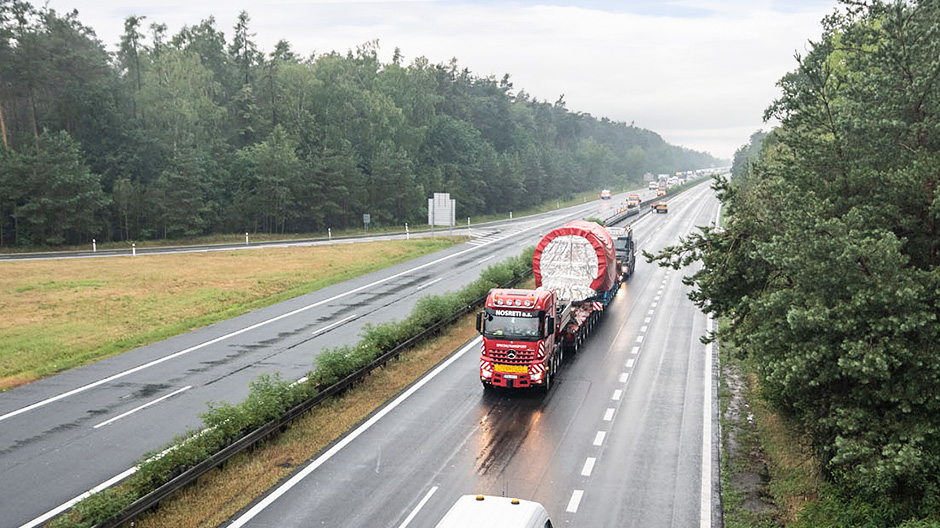
The company has been relying on Mercedes-Benz vehicles for some years now. It owns two heavy-duty Actros semitrailer trucks which pull a modular heavy-duty THP semitrailer produced by Goldhofer. The other three towing vehicles are used for transporting lighter loads. The company chose technology bearing the three-pointed star following their positive experience with the Actros. “The Arocs is however ideal for our sector. They are simply reliable, strong, high-performance vehicles and we can rely on them even when completing the most difficult transport jobs,” Ales Havlasek continues.
Very few people have an idea of the complex logistics involved before a heavy-duty transport can take to the road. Beforehand there are many months of planning, negotiation, calculation and of course the procurement of very different permits and approvals that are essential for transit. “The time and energy required for the planning are always individual and very different; it depends on the actual loading parameters of the order,” says Petr Gelnar, head of the department for route planning. “We needed almost 6 months planning time for the transportation of the stator and a team of ten people.”
“The Arocs is ideal for our sector. They are simply reliable, strong, high-performance vehicles and we can rely on them even when completing the most difficult transport jobs.”
– Petr Gelnar, head of the department for route planning at NOSRETI Specialtransport
Many factors must be taken into account during preparation. Key issues are, for example, clearance levels and the load capacity of bridges, current road blocks and other obstacles and restrictions. Route planning is not easy in the summer months in particular as numerous road blocks must be taken into account. “We can’t disregard the weather forecast either; for example when storms, heavy rain or snow are forecast. We need to be ready for all challenges from Mother Nature,” Gelnar continues.
The notorious sluggishness of administration also makes life difficult for the people at NOSRETI when planning the route. Before a gigantic load can be sent on its ways along a difficult route, all of the necessary permits must be clarified and procured in a lengthy process. The approval of all road authorities along the transport route is needed – and their response can go one way or the other. If an application is refused, there are then two possible courses of action: either a substitute route or a return to the negotiation table in order to continue discussion with those responsible.
Sometimes the approval process is further complicated by road wear and tear or the worsening condition of bridges. Or to be more precise: if you have driven over a bridge ten times, that doesn't mean that it will be possible an eleventh time. The physical wear on the bridge may have worsened in the meantime and then the load’s weight is simply too high. “Only when we have all of the permits, do we contact the Department of Transport,” says Gelnar. “As the highest authority, they provide us with approval for special use of the roads.”
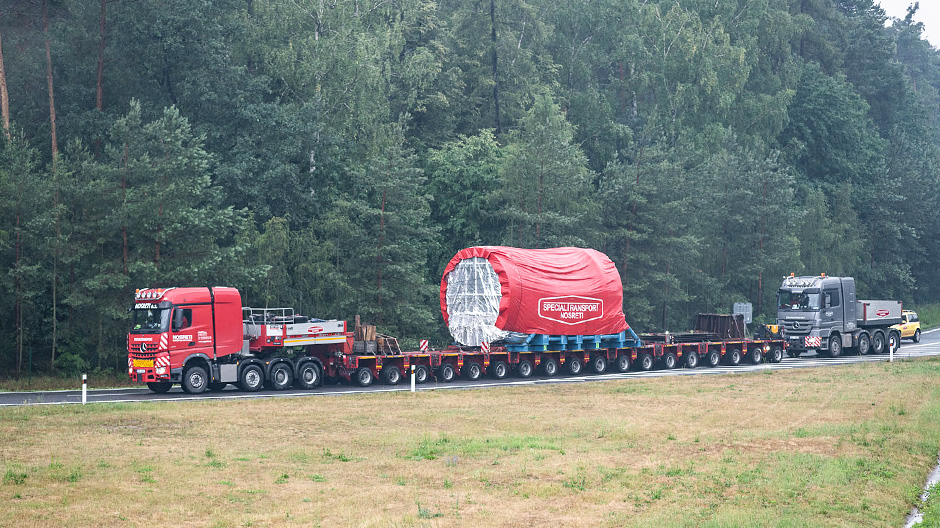
47.5 metres. The length of the special transport alone is impressive – the Arocs tows at the front and the Actros pushes at the rear.
The three-month long permanent authorisation, usually for loads of up to 48 tonnes and a width of 3.5 metres is somewhat easier. With regard to these loads it is clear that their weight will not endanger any bridge constructions because they are not extremely heavy. Three-month approvals are granted for transporting loads on motorways and trunk roads. In the main, these are required for military and agricultural machines.
Often support is required from other official institutions in order to put heavy-duty or special transport loads onto the road and ensure that everything runs smoothly. Thus working together with energy experts from the Czech rail company or telecommunication providers is part of their everyday routine as these must switch off or disassemble overhead cables. They often have to work closely with the police whose flashing blue lights lend importance to the transportation convoy and ensure that other road users afford them the necessary consideration. Transporting the giant stator for the Mochovce power station also required working together with the police. Their help was required because the parameters of the load were larger than those that do not require a police escort.
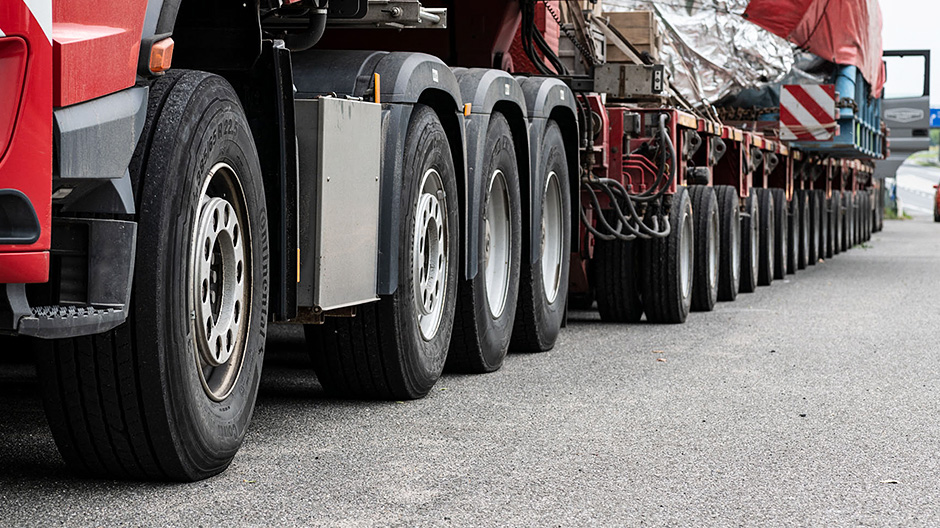
Axles, axles, axles. NOSRETI can transport loads weighing in at up to 400 tonnes on the road without a problem.
Can anything unexpected or surprising happen during special transport operations? The head of route planning nods his head in agreement. “If we are transporting machine parts weighing 160 tonnes and which are seven metres wide, it's actually funny when a fair with a carousel and a bouncy castle appears overnight on a route that was checked and authorised beforehand,” Petr Gelnar tells us with a grin. “Even though at the time it is a real problem for our project team that has to be solved immediately.”
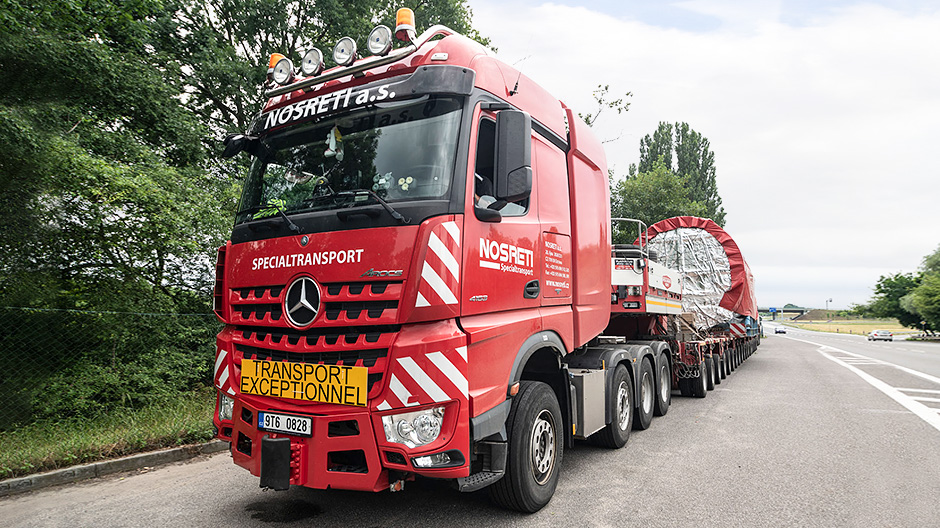
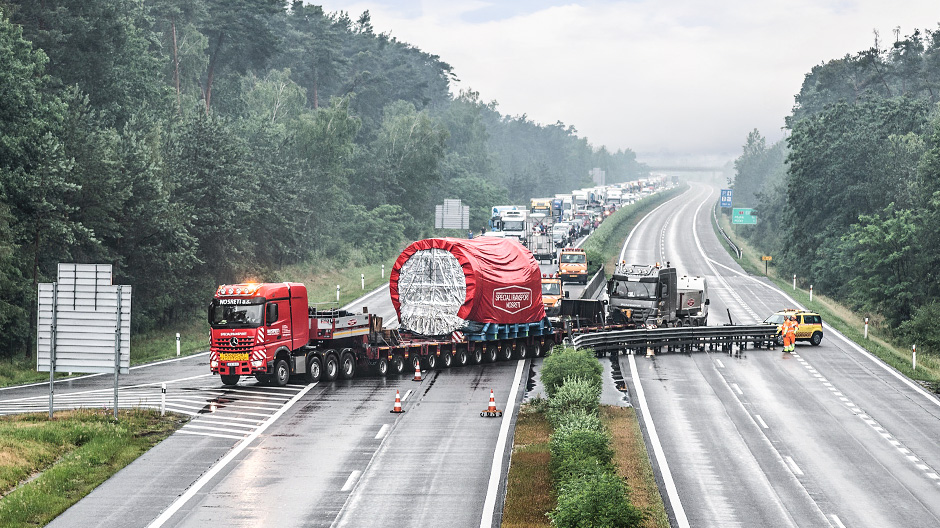
This time neither a carousel nor a bouncy castle obstructed the red NOSRETI Arocs while it was on the road. However, its journey though the Czech Republic into Slovakia still didn’t go completely smoothly.
The team met with smaller problems in the city of Slaný in the central Bohemian region. “There were roadworks in the village of Vitov, not far from Slaný. At the same time as we were driving through, excavation work was taking place.
The construction company had dug a fairly deep hole which would have made a smooth journey difficult for us.
That is why we asked the construction company to agree to temporarily fill in the hole so that we could drive past safely,” Petr Gelnar describes the less pleasant aspects of the transport operation.
Fortunately this was the only difficulty road traffic presented on the journey. The transport that arrived in Pilsen just before midnight on Sunday, passed through the gates of Slovakia’s Mochovce nuclear power station on Friday of the following week at three in the morning. The Stator with its 184 tonnes was finally at its destination. At NOSRETI everyone was duly satisfied: as usual, the vehicle team and the whole project team had worked excellently!
Photos: MediaTrust




Comment
Please log in to post a comment.
20 comments
als Daimler Fan glaube ich, dass die Leistungsfähigkeit von Actros und Arocs Schwerlastzugfahrzeugen erhöht werden muss. MAN hat gerade das Drehmoment seines 640PS Motors mittels Drehmomentwandlers auf 4.740 NM erhöht und die Zugfähigkeit der Volvo Schwerlastzugmaschine von 325 Tonnen ist ja schon länger bekannt. Der hier geschilderte Transport hätte also locker mit einer Schwerlastzugmschine bewältigt werden können. Ich hoffe daher, dass Daimler zumindest die Drehmomente des OM473 in allen Leistungsstufen rechtzeitig erhöht
Freundliche Grüße von einem LKW-Fan, der aber reiner Theoretiker ist
als Daimler Fan glaube ich, dass die Leistungsfähigkeit von Actros und Arocs Schwerlastzugfahrzeugen erhöht werden muss. MAN hat gerade das Drehmoment seines 640PS Motors mittels Drehmomentwandlers auf 4.740 NM erhöht und die Zugfähigkeit der Volvo Schwerlastzugmaschine von 325 Tonnen ist ja schon länger bekannt. Der hier geschilderte Transport hätte also locker mit einer Schwerlastzugmschine bewältigt werden können. Ich hoffe daher, dass Daimler zumindest die Drehmomente des OM473 in allen Leistungsstufen rechtzeitig erhöht
Freundliche Grüße von einem LKW-Fan, der aber reiner Theoretiker ist
die Leistungsfähigkeit von Schwerlastzugmaschinen für +180t ist nicht alleine von der Motorleistung abhängig, Rahmen (Schwerlastkupplung vo+hi), Kühlleistung, verschleißfreies Rangieren, Getriebe, Übersetzung.. spielen eine viel wichtigere Rolle. Im Falle vom Löwen reduziert sich das Drehmoment ab dem Anfahrvorgang immer weiter bis die Drehzahl von Motor+Getriebe annähernd gleich ist, dann wird überbrückt und es liegen maximal 3000Nm an. Beim Schweden sind zwar mehr ZGG angegeben, er hat aber keine Heckkühlanlage oder eine komplett verschleißfreie Kupplung. Die gefahrene Strecke durch CZ+SK war sicherlich auch mit einigen Steigungen gespickt also sind 2 Zugfahrzeuge immer von Vorteil, bergauf oder bergab. Außerdem vermute ich, dass auch in den Genehmigungen 2 Fahrzeuge vorgeschrieben sind. Von Ausfallsicherheit, Flexibilität in der Routenplanung (Fahrtrichtungswechsel) noch gar nicht gesprochen... Falls ein Fahrzeug schlapp macht kann man immer noch aus Gefahrenbereich oder Engstellen hinausfahren.
mit freundlichen Grüßen
Thomas
die Leistungsfähigkeit von Schwerlastzugmaschinen für +180t ist nicht alleine von der Motorleistung abhängig, Rahmen (Schwerlastkupplung vo+hi), Kühlleistung, verschleißfreies Rangieren, Getriebe, Übersetzung.. spielen eine viel wichtigere Rolle. Im Falle vom Löwen reduziert sich das Drehmoment ab dem Anfahrvorgang immer weiter bis die Drehzahl von Motor+Getriebe annähernd gleich ist, dann wird überbrückt und es liegen maximal 3000Nm an. Beim Schweden sind zwar mehr ZGG angegeben, er hat aber keine Heckkühlanlage oder eine komplett verschleißfreie Kupplung. Die gefahrene Strecke durch CZ+SK war sicherlich auch mit einigen Steigungen gespickt also sind 2 Zugfahrzeuge immer von Vorteil, bergauf oder bergab. Außerdem vermute ich, dass auch in den Genehmigungen 2 Fahrzeuge vorgeschrieben sind. Von Ausfallsicherheit, Flexibilität in der Routenplanung (Fahrtrichtungswechsel) noch gar nicht gesprochen... Falls ein Fahrzeug schlapp macht kann man immer noch aus Gefahrenbereich oder Engstellen hinausfahren.
mit freundlichen Grüßen
Thomas
https://www.dw.com/de/am-rande-mercedes-schwerlast-lkw/av-17716245
https://www.youtube.com/watch?v=iVLCjJpp9ro
https://www.dw.com/de/am-rande-mercedes-schwerlast-lkw/av-17716245
https://www.youtube.com/watch?v=iVLCjJpp9ro
😀👍😊😎
😀👍😊😎
Gleich mal noch ins "duRohr" geschaut und siehe da, bewegte NOSRETI-Bilder: https://www.youtube.com/watch?v=KE7GddVaIJc
...könnte stundenlang zuschauen... und vermutlich sind das genau die Mercedes-Fahrzeuge aus dem RoadStars-Bericht hier 👍
Gruß
Klaus
Gleich mal noch ins "duRohr" geschaut und siehe da, bewegte NOSRETI-Bilder: https://www.youtube.com/watch?v=KE7GddVaIJc
...könnte stundenlang zuschauen... und vermutlich sind das genau die Mercedes-Fahrzeuge aus dem RoadStars-Bericht hier 👍
Gruß
Klaus
Für diese besondere Art von Transport braucht man volle Konzentration,Motivation und Geduld!!
HUT AB!!!👌👍🚛💨💨
..sehr interessante Informationen!
Für diese besondere Art von Transport braucht man volle Konzentration,Motivation und Geduld!!
HUT AB!!!👌👍🚛💨💨
..sehr interessante Informationen!
Ein interessanter Artikel und tolle Fotos.
An die Männer und Frauen, die diese Transporte durchführen, ich ziehe den Hut vor Euch!
👏👏👏👍👍👍💪💪💪⛟😎
Ein interessanter Artikel und tolle Fotos.
An die Männer und Frauen, die diese Transporte durchführen, ich ziehe den Hut vor Euch!
👏👏👏👍👍👍💪💪💪⛟😎
Wir finden auch, das muss eine echt nervenaufreibende Arbeit sein. Respekt! 💪
Wir finden auch, das muss eine echt nervenaufreibende Arbeit sein. Respekt! 💪
Der Job hat mir sehr viel Spaß gemacht, obwohl er sehr nervenaufreibend und stressig ist.
Es war eine schöne Zeit bis ein Herzinfarkt sagte, bis hierher und nicht weiter.
Jetzt werden eben kleinere Fahrzeuge gefahren und es macht genausoviel Spaß. 👍💪⛟😎
Der Job hat mir sehr viel Spaß gemacht, obwohl er sehr nervenaufreibend und stressig ist.
Es war eine schöne Zeit bis ein Herzinfarkt sagte, bis hierher und nicht weiter.
Jetzt werden eben kleinere Fahrzeuge gefahren und es macht genausoviel Spaß. 👍💪⛟😎